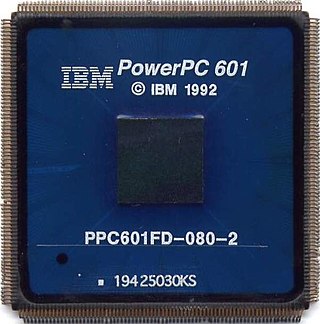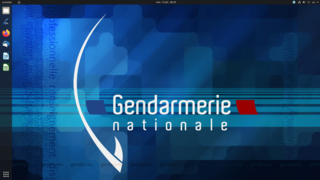Related Research Articles

PowerPC is a reduced instruction set computer (RISC) instruction set architecture (ISA) created by the 1991 Apple–IBM–Motorola alliance, known as AIM. PowerPC, as an evolving instruction set, has been named Power ISA since 2006, while the old name lives on as a trademark for some implementations of Power Architecture–based processors.

The University of Liverpool is a public research university in Liverpool, England. Founded in 1881 as University College Liverpool, Victoria University, it received Royal Charter by King Edward VII in 1903 attaining the decree to award degrees independently. The university withholds and operates assets on the National Heritage List, such as the Liverpool Royal Infirmary, the Ness Botanic Gardens, and the Victoria Gallery & Museum.

Project Athena was a joint project of MIT, Digital Equipment Corporation, and IBM to produce a campus-wide distributed computing environment for educational use. It was launched in 1983, and research and development ran until June 30, 1991. As of 2023, Athena is still in production use at MIT. It works as software that makes a machine a thin client, that will download educational applications from the MIT servers on demand.

International Computers Limited (ICL) was a British computer hardware, computer software and computer services company that operated from 1968 until 2002. It was formed through a merger of International Computers and Tabulators (ICT), English Electric Computers (EEC) and Elliott Automation in 1968. The company's most successful product line was the ICL 2900 Series range of mainframe computers.

Information and communications technology (ICT) is an extensional term for information technology (IT) that stresses the role of unified communications and the integration of telecommunications and computers, as well as necessary enterprise software, middleware, storage and audiovisual, that enable users to access, store, transmit, understand and manipulate information.
Green computing, green IT, or Information and Communication Technology Sustainability, is the study and practice of environmentally sustainable computing or IT.

The Saipem 7000 is the world's third largest semi-submersible crane vessel, after the SSCV Sleipnir and the SSCV Thialf. It is owned by the Italian oil and gas industry contractor Saipem S.p.A.
Hibernation in computing is powering down a computer while retaining its state. When hibernation begins, the computer saves the contents of its random access memory (RAM) to a hard disk or other non-volatile storage. When the computer is turned on the RAM is restored and the computer is exactly as it was before entering hibernation. Hibernation was first implemented in 1992 and patented by Compaq Computer Corporation in Houston, Texas.
Jiangsu Lemote Tech Co., Ltd or Lemote is a computer company established as a joint venture between the Jiangsu Menglan Group and the Chinese Institute of Computing Technology, involved in computer hardware and software products, services, and projects.
Collie Power Station is a power station in Collie, Western Australia. It is coal powered with one steam turbine that generates a total capacity of 300 megawatts of electricity. The coal is mined locally from the Collie Sub-basin and is transported to the power plant by overland conveyor. On 14 June 2022 the state government announced that Synergy would close Collie Power Station by 2027.

Intel Active Management Technology (AMT) is hardware and firmware for remote out-of-band management of select business computers, running on the Intel Management Engine, a microprocessor subsystem not exposed to the user, intended for monitoring, maintenance, updating, and repairing systems. Out-of-band (OOB) or hardware-based management is different from software-based management and software management agents.
The Climate Savers Computing Initiative was a nonprofit group of consumers, businesses and conservation organizations dedicated to promoting smart technologies that improve power efficiency and reduce energy consumption of computers. Formed in 2007, it was based in Portland, Oregon. In July 2012, Climate Savers Computing Initiative combined with The Green Grid and its programs continue within that organization.

A home energy monitor is a device that provides information about a personal electrical energy usage to a consumer of electricity. Devices may display the amount of electricity used, plus the cost of energy used and estimates of greenhouse gas emissions. The purpose of such devices is to assist in the management of power consumption. Several initiatives has been launched to increase the usage of home energy monitors. Studies have shown a reduction of home energy when the devices are used.
IT energy management or Green IT is the analysis and management of energy demand within the Information Technology department in any organization. IT energy demand accounts for approximately 2% of global CO2 emissions, approximately the same level as aviation, and represents over 10% of all the global energy consumption. IT can account for 25% of a modern office building's energy cost.
PC power management refers to software-based mechanisms for controlling the power use of personal computer hardware. This is typically achieved through software that puts the hardware into the lowest power demand state available, making it an aspect of green computing.
Verdiem was a software corporation based in Seattle, Washington, USA. The company was backed by venture capital. The company was acquired by Aptean on January 12, 2015.
Productivity software is application software used for producing information. Its names arose from it increasing productivity, especially of individual office workers, from typists to knowledge workers, although its scope is now wider than that. Office suites, which brought word processing, spreadsheet, and relational database programs to the desktop in the 1980s, are the core example of productivity software. They revolutionized the office with the magnitude of the productivity increase they brought as compared with the pre-1980s office environments of typewriters, paper filing, and handwritten lists and ledgers. In the United States, some 78% of "middle-skill" occupations now require the use of productivity software. In the 2010s, productivity software had become even more consumerized than it already was, as computing became ever more integrated into daily personal life.

GendBuntu is a version of Ubuntu adapted for use by France's National Gendarmerie. The Gendarmerie have pioneered the use of open source software on servers and personal computers since 2005 when it adopted the OpenOffice.org office suite, making the OpenDocument .odf format its nationwide standard.
UniPhi is a Project management software founded by Mark Heath. UniPhi spun out of mbh management in 2011 following the roll out of AECOM's Global Unite project.

ECOCITIES is an energy optimization system for building portfolios combining and extending the benefits of Energy Management Software (EMS), Computer-aided Facility Management (CAFM) software and building portfolio management software. It integrates building administration and monitoring, energy accounting and building portfolio optimization. Thereby, it supports the definition of low carbon action plans in terms of environmental impact and financial impact.
References
- ↑ "Ovum: Selecting a PC Power Management SolutionVendor".
- ↑ "University of Liverpool PowerDown Homepage". Archived from the original on 2010-11-27.
- ↑ "451 Group Market Research".
- ↑ "Saipem S.p.A. Green PC Project".
- ↑ "Eni subsidiary, Saipem S.p.A. PowerMAN Review" (PDF).
- ↑ "PowerMAN software assists college's sustainability efforts".
- ↑ "Live Green loan helps college power down idle PCs".
- ↑ "Liverpool's campus claw-back".
- ↑ "The University of Nottingham: Green IT".
- ↑ "About Data Synergy".
- ↑ "UEA Desktop Computer Power Monitoring and Management" (PDF).
- ↑ "PowerMAN at London School of Hygiene and Tropical Medicine PC energy waste project".
- ↑ "Climate Savers Computing Initiative Member Directory".
- ↑ "PowerMAN software features".
- ↑ "University of Nottingham: 'Greening' our services" (PDF).
- ↑ "Switching off How to save a million hours and £140,000" (PDF).
- ↑ "Experiences with Running MATLAB Applications on a Power-Saving Condor Pool" (PDF).
- ↑ "University of Liverpool runs Condor alongside PowerMAN".
- ↑ "Presentation: Experiences with running MATLAB jobs on a power-saving Condor Pool".
- ↑ "L Nelson – PowerMan".
- ↑ "The Sustainable Desktop?, University of Sheffield, 2 September 2008".
- ↑ "University of Nottingham: Making the switch with PowerMAN".
- ↑ "University of Nottingham saving £325 every day with Data Synergy PowerMAN and WakeMyPC" (PDF).
- ↑ "Sheffield NHS Hospitals PC Power Management".
- ↑ "PowerMAN software assists college's sustainability efforts".
- ↑ "Live Green Loan Fund – Project Profile College of Human Sciences: Computer Power Down Software".
- ↑ "Salix Finance Energy Efficient ICT Workshop – Nottingham Trent University" (PDF).
- ↑ "PowerMAN power management – University of Sussex".
- ↑ "PowerMAN rescues University's IT carbon impact".
- ↑ "University of Leicester Environment Team Issue 3: October 2012 Newsletter" (PDF).
- ↑ "Salix Finance Energy Efficient ICT Workshop" (PDF).
- ↑ "The UEA SISP Project".
- ↑ "UEA SISP project Update March 2010".
- ↑ "SISP Project – Final Report".
- ↑ "UEA Desktop Computer Power Monitoring and Management" (PDF).
- ↑ "University of Oxford: Keeping IT Clean".
- ↑ "Lisa Nelson PowerMAN Case Study Slides".
- ↑ "Lisa Nelson Liverpool PowerMAN Case Study presentation audio".